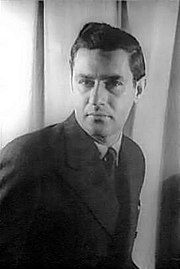Amelia Goes to the Ball
| Amelia al ballo Amelia Goes to the Ball |
|
|---|---|
| Opera buffa by Gian Carlo Menotti | |

The composer in 1944
|
|
| Librettist | Menotti |
| Language | Italian |
| Premiere | April 1, 1937 (in English) Curtis Institute of Music, Philadeplphia |
Amelia al ballo (Amelia Goes to the Ball) is a one-act opera buffa by Gian Carlo Menotti, who set his own Italian libretto. Composed during 1936 when Menotti was in his mid-twenties, it was the composer's first mature opera and first critical success. The opera recounts a series of farcical events as a young Italian socialite overcomes obstacles to her attendance at the first ball of the season.
Menotti secured a premiere for the work in Philadelphia. This required, however, a translation into English of the original libretto. George Mead prepared the translation and Menotti made minor revisions to the music to fit the new English words. Staged by the Curtis Institute of Music, Amelia Goes to the Ball premiered on 1 April 1937 at the Philadelphia Academy of Music under the direction of Austrian composer, librettist, and stage director Ernst Lert, with set and costume designs by Tony Award-winning designer Donald Oenslager.
The opera was presented in a double bill with the US premiere of Darius Milhaud's Le pauvre matelot. Both operas were conducted by Fritz Reiner. Sylvan Levin served as chorus master, and a young Boris Goldovsky worked as assistant conductor. The double bill played later that month in Baltimore at the Lyric Theatre and at the New Amsterdam Theatre in New York City, with Florence Kirk taking over the title role at the latter theatre. On 2 May 1937 excerpts from the Menotti opera, performed by the original cast with Levin conducting, were broadcast by CBS Radio as part of National Music Week in the United States.
Still in its English guise, Amelia Goes to the Ball had its Metropolitan Opera premiere on 3 March 1938 with Muriel Dickson as Amelia, John Brownlee as her husband, and Mario Chamlee as her lover, under the baton of Ettore Panizza. The opera received a total of seven performances at the Met that season, four times in a double bill with Strauss' Elektra (including the opening night), twice paired with Strauss' Salome, and once with Rimsky-Korsakov's Le coq d'or.
...
Wikipedia
